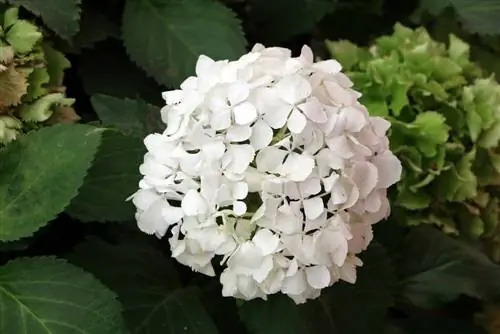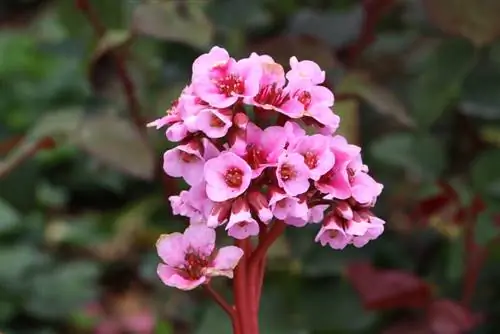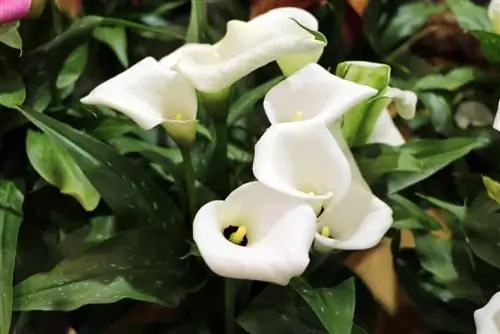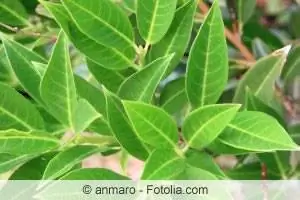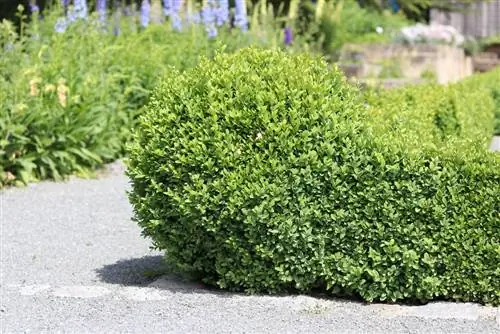- Author admin [email protected].
- Public 2023-12-17 03:39.
- Last modified 2025-01-24 12:45.
The main premise for a lush hydrangea bloom is a balanced supply of nutrients. The capricious flower beauties have special requirements when it comes to cultivation that need to be taken into account. The soil should be slightly acidic and rich in nutrients. Since their energy requirements are at a high level, hydrangeas require a constant supply. Anyone who resorts to the next best fertilizer, skimps on the nutrient supply or gives too much of a good thing will incur the displeasure of their demanding ornamental trees. Read here what you should fertilize hydrangeas with and how often?
The right hydrangea fertilizer
In order to produce their magnificent flowers and leaves, hydrangeas need plenty of energy. Since the surrounding soil can only supply the required amount to a limited extent, support with adequate fertilizers is essential. This is important for a flourishing flowering tree shortly after planting, not least in the limited substrate volume of a pot. In this respect, the requirements of Hydrangea fall outside the usual framework of classic ornamental shrubs. We have put together an overview of the criteria the right hydrangea fertilizer should meet here:
- High nitrogen content for the growth of leaves and flowers
- A rich supply of potassium for flower induction and flower abundance
- Low phosphorus so that the pH value does not rise excessively
- Trace elements such as iron, magnesium, sulfur, zinc, manganese and others
- An acidic pH value of less than 5 so that the nutrients are available to the roots
In order to cover the nutrient requirements of hydrangeas according to these specifications, a wide range of fertilizers are available to choose from. However, using a commercially available complete fertilizer such as Blaukorn is not recommended, as its composition is aimed at completely different specified requirements. It is better to opt for a mineral or mineral-organic special fertilizer from a specialist retailer. You can optionally fertilize hydrangea purely organically, although here too the specific requirements should be kept in mind.
Mineral and mineral-organic complete fertilizers for hydrangeas in beds
Beckmann hydrangea fertilizer
The mineral-organic solid fertilizer meets the requirements of hydrangeas with an NPK composition of 6+5+10. In addition, the product contains 200 grams of alum in an extra bag for the blue coloring of pink Hydrangea macrophylla.
- Dosage: 80 grams per square meter
- Frequency: From March to August every 3 months
Gärtner’s Hydrangea Fertilizer
Mineral-organic solid fertilizer with an NPK nutrient ratio of 8+3+5, precisely balanced for the needs of a garden, farmer's or plate hydrangea. The product is available with a practical measuring spoon.
- Dosage: 40 grams per square meter
- Frequency: Spread and incorporate every 3-4 weeks from March to July
Substral Osmocot rhododendron and hydrangea fertilizer
The innovative sustained release fertilizer comes with resin-coated fertilizer beads and has a long duration of action. The resin layer ensures that the nutrients with NPK 16+9+10 as well as numerous trace nutrients are only gradually released to the hydrangeas. This means that despite the fairly high concentration of nutrient carriers, an overdose cannot occur.
- Dosage: 60-80 g per ornamental shrub
- Frequency: 1 application in March
Tip:
Solid fertilizers are spread according to the dosage instructions and lightly worked into the soil surface. Afterwards, extensive watering has the highest priority for optimal effectiveness.
Mineral and mineral-organic liquid fertilizers for potted hydrangeas
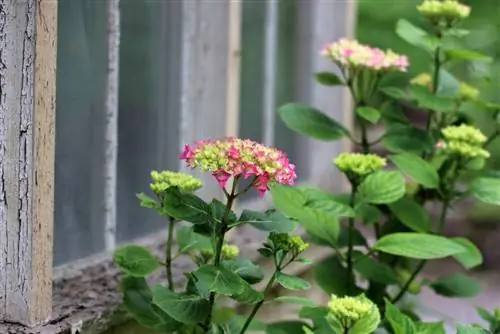
Compo hydrangea and camellia fertilizer
The liquid special fertilizer for potted hydrangeas impresses with an NPK formulation of 7+3+6 as well as various trace nutrients. The product also contains iron to support rich green leaf color and abundant flowering.
- Dosage: 1 cap per 5 liters of water
- Frequency: From March to August every 14 days
Cuxin liquid for hydrangeas and rhododendrons
In this liquid preparation, the organic components outweigh the mineral nutrients, so that a gentle effect is exerted on the hydrangeas. Iron is added to the NPK composition of 4+5+6 for a rich green leaf color.
- Dosage: 3-5 ml to 1 liter of irrigation water
- Frequency: Add to irrigation water 2 to 3 times every week from March to July
Chrystal hydrangeas and azaleas
The liquid fertilizer, balanced with a nutrient combination of NPK 6+4+7, not only supplies hungry hydrangeas in the pot with the main nutrients, but is also equipped with the Vitamin Plus system. This means that the flowering tree receives plenty of trace elements for a long flowering period and robust winter hardiness.
- Dosage: 10 ml in 1 liter of water
- Frequency: Add to irrigation water weekly from March to August
Special fertilizer for a blue color in beds and containers
Compo Blue Hydrangeas
Water-soluble fertilizer with aluminum for the targeted blue coloring of pink garden hydrangeas. The powder can either be spread or dissolved in water.
- Dosage: Sprinkle 1 measuring spoon (included) on the bush or add it to 2 liters of irrigation water
- Frequency: From March to October, whenever the blue color fades
Norax hydrangea fertilizer 'gardener quality' with deep blue dye
The fertilizer product scores with an NPK dosage of 8+6+8 plus 2 percent alum for wonderfully blue hydrangea flowers. Thanks to organic ingredients, such as nitrogen-rich horn shavings, the mineral-organic preparation also makes a valuable contribution to maintaining soil quality.
- Dosage: 50-80 g per hydrangea bush
- Frequency: In March and June
Terrasan Hydrangea Fertilizer Blue
The traditional manufacturer of sophisticated special fertilizers offers hobby gardeners an inexpensive hydrangea fertilizer that meets expectations with an NPK composition of 7+3+5. However, the alum it contains is enough to give it a blue color. Experience has shown that the dosage for adult hydrangeas is not sufficient to change the color of a pink garden hydrangea to an intense shade of blue.
- Dosage: 1 cap per 3 liters of irrigation water
- Frequency: Every 8 to 14 days from March to September or when the blue color fades
Tip:
In order to transform a pink-flowering hydrangea or hydrangea into a bright blue flower beauty, it is not absolutely necessary to purchase special fertilizers for the blue color. As long as all the conditions are right, regular administration of alum from the pharmacy is sufficient. Spread regularly from March to August at an average dosage of 50 grams per bush, the pH value remains at 4 to 4.5 and the blue color lasts.
Organic fertilizers
Environmentally conscious hobby gardeners can easily remain faithful to their ecologically oriented garden care and still provide their hydrangeas with sufficient nutrients. As long as an organic fertilizer is designed not to affect the acidic pH value, there is nothing standing in the way of natural care for the magnificent flowering trees. The following organic fertilizers can be made yourself, which will noticeably reduce the burden on your wallet.
Leaf compost
The prime example of acidic compost is created after oak leaves have rotted for 2 years. If this organic fertilizer is not explicitly intended to cause a blue color, birch, alder or other types of foliage can be added. The common method of accelerating composting with lime is not recommended in this exceptional case.
- Dosage: Work in a 2-3 cm high layer of compost and water
- Frequency: From March to the end of August every 2 weeks
Coniferous compost
Coniferous compost aims in a similar direction to the leaf compost mentioned above. What is likely to be disadvantageous is that the rot lasts up to 3 years. If only the finer spruce and larch needles are composted instead of thick pine needles, the process is over after just 2 years. The alternating layering with grass clippings has a beneficial effect.
- Dosage: Spread a 2-3 cm thick layer, rake in and water
- Frequency: From March to the end of August every 2 weeks
Horn shavings / horn meal
There is plenty of nitrogen in the crushed and ground hooves and horns of slaughtered cattle. Since hungry hydrangeas explicitly demand this nutrient, ecologically oriented hobby gardeners always have horn shavings and horn meal on hand.
- Dosage: Rake a handful flatly into the substrate on each bush
- Frequency: Once at the start of the season in March/April
Coffee grounds
Dried coffee grounds are rich in nitrogen, potassium and magnesium. In addition, the home remedy lowers the pH value of the soil to a small extent. Since the caffeine it contains also has a toxic effect on voracious snails, environmentally conscious hydrangea gardeners use coffee grounds as a supplementary fertilizer.
- Dosage: Spread a thin layer on the root disc
- Frequency: From March to July after every rain
If there are no options for producing compost in the garden, specialist retailers offer suitable natural products. The Azet hydrangea fertilizer from Neudorff, for example, only contains plant and animal-based nutrient carriers.
Conclusion
Profusely blooming hydrangeas always result from a carefully balanced supply of nutrients. Since the classic complete fertilizer does not correspond to the requirements of hydrangea, specially formulated fertilizers are required. Suitable preparations are rich in nitrogen and potassium and low in phosphorus. In this way, the high nutrient requirements of these opulent flowering trees are taken into account as well as their desire for an acidic pH value of 4 to a maximum of 5.5. The extent to which you prefer a mineral, mineral-organic or purely organic fertilizer is up to your individual decision.

